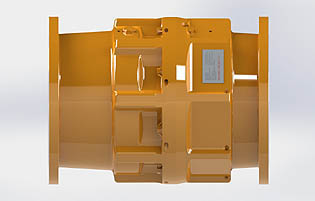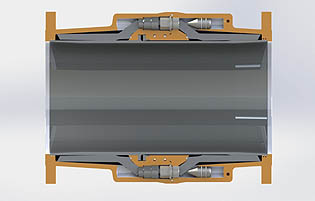Petal Valve Marine Breakaway Couplings
Features and benefits
The experience and unique talents at Gall Thomson were applied to the design, development and extensive testing of the Petal Valve Marine Breakaway Coupling.
Interestingly, several other companies have developed products to compete with the Gall Thomson MBC but all have failed, indicating the highly specialised nature of this market arena.
Considerable investment and research resulted in a reliable system that delivers distinct benefits to a transfer system operating to the demands of legislation and the expectations of governments and modern commerce.
In the event of a breakout, the device will operate without any outside intervention by personnel or system.
Important benefits
- Valve closure speed can be altered in service without dismantling unit.
- Completely self contained – no outside power source required.
- Activation due to linear overload and/or extreme internal pressure, providing surge protection.
- Simple petal mechanism – no axles, shafts, hubs or bearings to seize.
- Sealed internals until an activation occurs.
- Low weight – compact design.
- Fits between standard flanges at any recommended location in hose assembly.
- Variable closure speed gives anti-shock shut down.
- Dynamic parting loads can be varied to suit system.
- Re-usable.
- Piggable.
- Fail safe.
MBC Petal Valve options
- Safety breakaway with single or double, controlled or instantaneous, anti-pollution petal valve closure.
- Safety breakaway with anti-pollution petal valve closure and internal pressure stabilisation.
- Safety breakaway with internal pressure stabilisation only.
- Single controlled or instantaneous closure units are also available.
Activation by internal pressure can be prevented – allowing breakaway only on dynamic loads, if required.
Material composition
Offshore grade forgings are used for the main body components. The break assembly is made from high grade titanium alloy that is rated, tested and certified.
Extensive testing of materials, combined with many years of field experience, ensures performance integrity and reliability in all environmental conditions.
Materials can be varied to suit desired specifications.
Breakstud
The final breakstud rating is determined following basic calibration and proof tensile testing on sample breakstuds. These samples are machined from the same titanium material in its final treated condition as used in the final product.
These breakstuds are not shearbolts and therefore act in controllable tension.
Standard unit:
The Standard Unit will activate in two circumstances.
Linear overload:
The Standard Unit will part on linear overload. This may occur due to a tanker moving off station due to a manoeuvring fault, an unexpected wave, wind or general inclement weather conditions.
In cases of tanker breakouts or extreme pressure surge incidents where no MBC is installed, the consequences can be horrendous, with ruptured hoses and major oil spills. However, with an MBC installed system damage will be avoided and pollution will be prevented.
Flow pressure surge:
The Standard unit will activate where an extreme internal pressure surge occurs: caused by an unusual event such as an inadvertent sudden valve closure downstream of the breakaway coupling.
Stabilised unit:
The Stabilised unit will activate in one circumstance.
Linear overload:
The Stabilised Unit will activate on linear overload as with the Standard Unit.
Flow pressure surge:
The Stabilised Unit will not activate due to a pressure surge but is instead designed to possess the same integrity as the rest of the transfer system.



